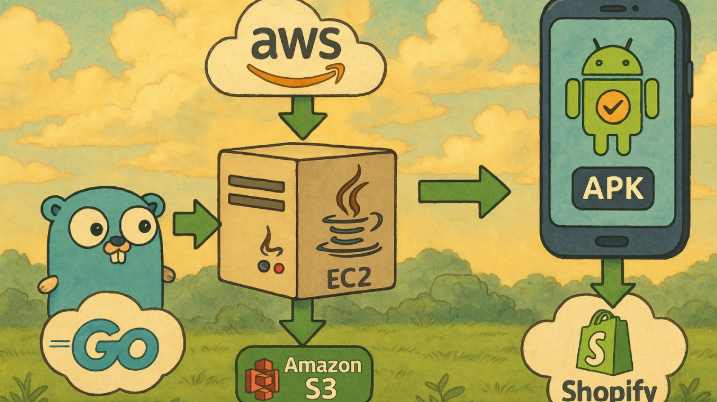At NoShopCode, our goal is simple 🎯. We allow any Shopify store owner to launch their own mobile app without writing code. However, as more clients started coming in, we needed something powerful on the backend. Therefore, we built an automated APK build system that generates Android apps on demand.
The Problem We Were Solving 🤔
Every store had unique branding, API keys, assets, and build configuration. Moreover, building each app manually was slow and unreliable. Additionally, using a shared server was costly 💸.
Furthermore, we didn’t want to maintain long-running build servers that sat idle most of the day. Therefore, we asked ourselves: “Can we create a system that only comes alive when needed, builds the APK, and disappears after it’s done?”
Fortunately, the answer was yes ✅. Subsequently, it changed everything.
How the Automated APK CI/CD Pipeline Works ⚙️
When a Shopify store owner clicks “Build App” on NoShopCode, here’s what happens with our automated APK system:
1. Go Service Handles the Request First, a lightweight Go backend receives the build request. Then, it queues it and kicks off the automation.
2. EC2 Instance Spins Up from AMI ☁️ Next, a fresh EC2 instance launches using a preconfigured AMI image. Moreover, this image already has all required Android SDKs, Java, Gradle, Node, and dependencies.
3. Git Clone and Java Build Begins Subsequently, the instance clones the appropriate repo and branch based on the customer’s store config. After that, the app is built using Java and the latest Android Gradle toolchain.
4. APK Uploads to Amazon S3 Once the build succeeds, the automated APK uploads to S3. Additionally, a download link is sent back to the client.
5. Auto-Termination Finally, as soon as the job finishes, the EC2 instance terminates itself. Therefore, there’s no idle time and no leftover resources.
Why Go and Java for Automated APK Builds?
Go (Golang) ⚙️ We used Go to build our orchestration layer. First, it’s fast. Second, it handles concurrent tasks excellently. Furthermore, it’s perfect for lightweight API servers and command execution.
Java (Inside the Build Instance) ☕ Meanwhile, Java is essential for modern Android builds. We used Java with Gradle because of its speed, compatibility with React Native, and overall stability.
Automated APK Pipeline Benefits We’re Seeing 📈
- Our automated APK pipeline delivers several key advantages:
- Fully Automated — First, the one-click build process requires zero manual work.
- Cost Efficient 💰 — Moreover, we pay only for the time the EC2 instance is running.
- Clean Builds — Additionally, there are no cache issues or stale configs.
- Scalable — Furthermore, the system can handle 1 or 100+ builds per day without slowing down.
- Isolated and Secure 🔒 — Finally, each build runs in its own environment.
Final Thoughts 💭
As a founder, I’ve learned that automation isn’t just nice-to-have. Instead, it’s a necessity if you want to scale without burning out.
This automated APK pipeline has saved us hours of dev time ⏰. Moreover, it has made our product more reliable, faster, and scalable. Now, every time a store owner clicks “Build App,” a clean Android app is ready in minutes. Most importantly, this happens with no manual involvement from our team.
If you’re working on something similar or want help setting up a build system like this, I’m happy to connect and share notes 🤝
Share your thoughts on how AI and automation are revolutionizing data analysis by checking out our LinkedIn post.
Also, check out our previous post: Automating Data Analysis and Reporting with AI

Leave a Reply
You must be logged in to post a comment.